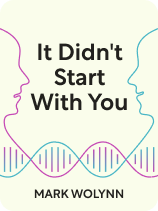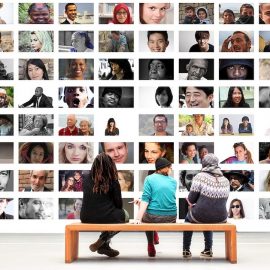

This article is an excerpt from the Shortform book guide to "It Didn't Start With You" by Mark Wolynn. Shortform has the world's best summaries and analyses of books you should be reading.
Like this article? Sign up for a free trial here .
Can childhood trauma be treated? How can you use language to find the source of your pain?
In his book It Didn’t Start With You, Mark Wolynn presents a language-based approach to treating adults suffering from childhood trauma. Wolynn argues that his therapeutic approach can produce results where traditional talk therapy and medication cannot.
Keep reading to learn about Mark Wolynn’s approach to childhood trauma therapy for adults.
A Language-Based Approach to Trauma Therapy
Wolynn asserts that how we talk about the things that cause us emotional or physical pain can lead us to the source of our trauma. His approach to childhood trauma therapy for adults involves asking people a series of questions and listening closely to their answers. Words and phrases that seem particularly impassioned, peculiar, or misplaced serve as beacons indicating that some trauma lies hidden below their awareness. Sometimes investigating our direct life experiences can reveal the source of the trauma, but other times we must trace the source back to prior generations.
Step #1: State Your Pain Point
The first step in Wolynn’s therapeutic approach involves identifying the aspect of your life that causes you the most stress or discomfort. The problem could relate to any area of your life such as your health, work, or relationships.
What’s the one thing—that if you could move beyond it—would provide you the most freedom? This is your pain point. Maybe you suffer from panic attacks, an eating disorder, or an aching feeling of loneliness. Or maybe you feel like your friends take advantage of you, or your partner is never there when you need her, or your boss never recognizes your contributions.
Once you’ve identified your pain point, Wolynn says to look for words and phrases that stand out as peculiar, emotional, or misplaced in the way you describe that problem. These words likely point to unresolved trauma in childhood or your family’s past.
Step #2: Describe Your Parents
Now that you’ve identified your pain point, the next step of childhood trauma therapy is to describe your parents—freely and without censoring yourself. To begin, explain what your mother was like when you were small. Was she playful, affectionate, and supportive? Or was she depressed, manipulative, and angry? Then, describe your father.
Again, Wolynn says to look for potent, emotional language in your descriptions. Those words and phrases will shed light on feelings and grievances that have been tucked away in your unconscious mind.
Wolynn argues that you will not be able to achieve true peace or freedom until you mend relationships with your parents, as these are defining relationships that form the model upon which you build all other relationships in your life.
Step #3: Identify Your Biggest Fear
After describing your parents, the third step is to identify what you fear most. Wolynn says that isolating and stating your biggest fear provides the best clue to unraveling your childhood trauma in therapy. This root fear, Wolynn asserts, stems from unresolved trauma, potentially originating in your family’s past.
When you state your biggest fear, Wolynn says, don’t just settle for your initial response. Keep drilling down to find the absolute deepest concern. If you say, “My worst fear is that no matter how hard I work, I’ll never get ahead,” keep digging. So what? What’s the worst thing about that? “I won’t have enough money to live, and I’ll lose my house.” Then what? “I’ll be homeless and I’ll probably get sick.” Keep going. “I’ll die in pain, alone and forgotten.”
The words you land on should affect you on a deep emotional level.
Step #4: Locate the Source of Your Trauma
Now that you’ve uncovered the specific struggles you face, how can you find the root of that trauma? The author suggests two methods for adults in therapy for childhood trauma.
The first option Wolynn suggests is to use questions that attempt to link your current angst to something that happened in the past. From the example above related to your biggest fear, you might ask, “Who in my family lost their house? Who ended up homeless? Did someone get severely ill without access to medical care? Who died alone away from their loved ones?”
You can use these exploratory questions on their own, or you can deepen your investigation by applying them in combination with the second option Wolynn suggests for uncovering the source of your trauma: building your family tree.
Once you’ve built your family tree, look closely and explore who could have had feelings or experiences that reflect your own. You might notice patterns that carry over multiple generations. Perhaps your great-grandmother’s first child was killed in a bombing. Your grandmother’s sibling drowned at a young age. Your mother’s second child was stillborn. And you have an intense fear of having children because you’re certain they will die a horrible death.

———End of Preview———
Like what you just read? Read the rest of the world's best book summary and analysis of Mark Wolynn's "It Didn't Start With You" at Shortform .
Here's what you'll find in our full It Didn't Start With You summary :
- A look into the causes of persistent anxiety, depression, and illness
- How the traumas of your past are stopping you from being truly happy and free
- How to resolve deeply-rooted trauma by applying a unique therapeutic approach






